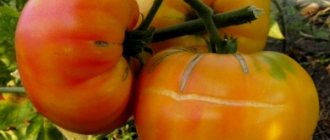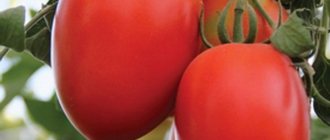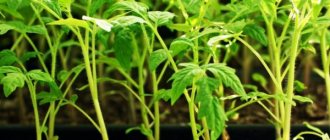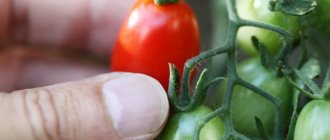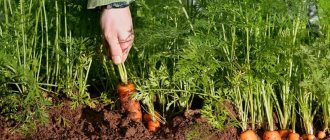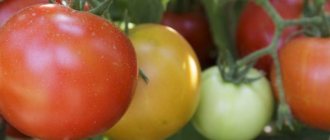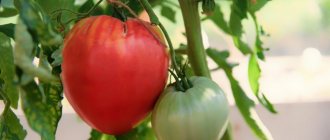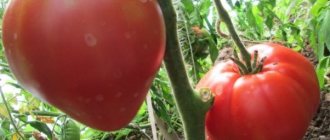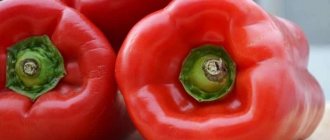Characteristics and description of the variety
The species is indeterminate, height 1.7-2.5 m. Spreading bushes, strong foliage . The first fruiting cluster is laid above the 9th leaf. 4-9 fruits are formed on each brush.
Reference! Indeterminate varieties do not have natural restrictions on shoot growth. To limit the growth of the plant, it is pinched.
An early ripening variety , 90 days pass from the emergence of seedlings to full ripening.
Productivity is high, from 1 sq. m, 6-7 kg of vegetables are collected , provided that no more than 3 seedlings are planted per 1 sq. m. m.
There is increased resistance to tobacco mosaic and late blight.
Reference! Tobacco mosaic is a viral disease, while late blight is a fungal disease.
The variety is well adapted to high ambient temperatures and high salt content in the soil. Recommended for cultivation in open ground and in greenhouse conditions.
Requires constant pinching and obligatory garter.
Fruit characteristics
The fruits are large, weight 300-350 g, round in shape, pink in color . The peel is thin, the flesh is juicy. The taste is excellent, sweet with a slight hint of sourness. There are 4-6 seed chambers.
Tomatoes are not stored for a long time, so they are immediately processed or consumed fresh . This variety is not used for pickling, marinades and preservation, but it exhibits good taste in pastes, ketchups, and juices. And, of course, vegetables are ideal in a fresh salad, in hot and vegetable dishes and in baked dishes.
Characteristics
The fruits are large, round, slightly flattened. Tomatoes reach a weight of 300-350 g. During the ripening process, they change from spotty green to rich pink. The pulp is juicy, not watery, with a rich sour-sweet taste. The acidity is moderate, the sugar content reaches 3.7%, dry matter - up to 7%.
The fruits are recommended for salads and preparing hot dishes. Ripe tomatoes make delicious sauces, juices and purees.
You can compare the weight of the fruits of this variety with others in the table below:
| Variety name | Fruit weight |
| Wild Rose | 300-350 grams |
| Pickling miracle | 90 grams |
| Locomotive | 120-150 grams |
| President 2 | 300 grams |
| Leopold | 80-100 grams |
| Katyusha | 120-150 grams |
| Aphrodite F1 | 90-110 grams |
| Aurora F1 | 100-140 grams |
| Anyuta F1 | 95-120 grams |
| Boni M | 75-100 |
How to grow seedlings
Sowing begins 2 months before planting seedlings in the ground . But before sowing seeds in the ground, they undergo special training.
Seed preparation
To get the highest percentage of germination, you will need high-quality planting material . To do this, take a good look at the seeds that you are going to sow: they should be light in color and without visible damage. Empty seeds are determined by immersing them in a saline solution (1 teaspoon of salt dissolved in a glass of water) for 10 minutes. Those seeds that float to the surface are not suitable for planting.
Disinfection of grains is carried out by immersion in a weak solution of potassium permanganate for 20 minutes . Then they are washed with running water, dried and soaked for 10-12 hours in a growth stimulator to improve germination.
Important! If you sow sprouted seeds, this will increase the germination percentage. The grains are wrapped in gauze, moistened with warm, at least 25 degrees, water and left in a dark and warm place for 2-3 days. After the sprouts appear, the seeds are sown in the ground.
Preparing the container and soil
Suitable soil is a mixture of garden soil with humus . It is light and fertile, which fully meets the requirements of the variety. Before sowing, the soil mixture is disinfected by pouring a solution of potassium permanganate or copper sulfate. You can plant them either in a common wooden box or in individual containers such as disposable plastic cups and peat pots.
Sowing
The seeds are sown slightly deeper and then sprinkled with a small amount of peat . The earth is moistened with a spray bottle and the planting containers are covered with film or glass to create a greenhouse effect. Then the containers are left in a dark and warm room, at a temperature of at least 22 C.
Growing and care
When the first shoots appear, the containers are placed in a well-lit place , but not in direct sunlight.
Caring for seedlings involves moderate watering as the top layer of soil dries out . Water with a small watering can or tablespoon with warm, settled water.
When 2 true leaves appear, the seedlings are picked and planted in separate containers.
During picking, the first fertilizing is carried out with complex mineral fertilizer . The same fertilizing is repeated before planting the seedlings in a permanent place.
Reference! Picking promotes the development of the root system and the proper growth of bushes.
Young bushes need warmth and periodic ventilation . But there is no need to create drafts, since drafts interfere with full development.
2 weeks before planting the seedlings in the ground, they are hardened off . The seedlings are taken outside for 2-3 hours, gradually increasing the time spent in the open air. The night temperature in the room where the seedlings are brought is reduced to 13 C.
➽ Tomato seedlings “Wild Rose”
Reviews about the variety
According to professional gardeners, those who have at least once planted Wild Rose tomatoes will never give up this variety of vegetable crop.
- Vladimir Stepanovich. Crimea. Wild rose tomatoes have been grown for 6 years. This variety of tomatoes has excellent taste, which is why our family loves it so much. Our climate is steppe and arid, but plants easily tolerate lack of moisture and heat, and vegetables quickly gain weight and become sweetish. Caring for the crop is simple and does not take much time and effort. The only inconvenience is that the bushes produce multiple shoots that need to be cut off periodically.
- Ekaterina Lvovna. Moscow region. Pink tomatoes have always been my weakness. But I was able to grow a full-fledged harvest of vegetables only after planting Wild Rose tomatoes. The culture is completely undemanding to weather conditions and easily tolerates the rainy season and temperature changes. The bushes grow tall, requiring additional care and pinching. But even such measures cannot interfere with obtaining a harvest of vegetables with an excellent, sweet taste and tomato aroma.
Previous
TomatoesTomato variety Auria: yield and description
Next
TomatoesTomatoes Honey Spas: yield and characteristics of the variety
How to grow tomatoes
After 60 days, the young bushes are ready for transplanting . They can be planted in a greenhouse in mid-May; they are transplanted into open ground when the threat of night frosts has passed and the ground has completely warmed up.
Landing
Planting pattern : 50 cm – distance between seedlings, 60 cm – between rows.
A small amount of ash or complex fertilizer is added to each hole . After transplantation, the seedlings are not watered for the first week, so they adapt to the new conditions. If plants are watered immediately after planting in the ground, they will not absorb moisture, which will lead to rotting of the roots.
Tomato care
After each watering, the soil is loosened and hilled up . This improves soil breathability and promotes full plant growth. Mulching with straw retains moisture in the beds, so the amount of watering can be reduced. But not in hot weather - during this period, on the contrary, they water more often.
The frequency of watering is no more than 2 times a week, and on hot and dry days 3-4 times. Water with warm, settled water at the roots of the plants. You can install drip irrigation using an ordinary plastic bottle without a bottom. It is buried next to the root system, filled with water, and the moisture gradually penetrates to the roots.
Feed the tomato once every 14 days with a complete complex fertilizer or organic matter . Bird droppings are used as organic matter, which is diluted in a ratio of 1:10. Such a strong dilution is explained by the fact that a highly concentrated solution can cause a burn to the root system.
Reference! It is not recommended to fertilize tomatoes with fresh manure, since it promotes the growth of green mass, while the developing fruits do not receive the required amount of nutrients.
Features of cultivation and possible difficulties
The culture needs constant pinching of bushes . The plant is grown in 1 or 2 stems. This technique increases the quantitative indicator of fruiting. The lower leaves must be removed. Otherwise, they will rot from moisture in the beds, and fungus will appear.
Gartering a tall crop is another important step in tomato care . The support is installed next to each seedling immediately after planting them in the ground. The support is provided by wooden stakes or metal rods, to which young bushes are immediately tied. Early garter ensures the formation of a strong and even stem.
Diseases and pests
Infections and pests rarely affect Wild Rose , but the risk of crop disease should never be neglected.
Preventative actions are an effective method of maintaining plant health . Fungus prevention includes regular loosening, hilling the beds, removing weeds with roots and mulching the soil. Weeds hide many pests that spread to any crops, causing them harm. Loosening the soil prevents the penetration of insects that move underground and damage the root system, and mulch protects against slugs, preventing them from getting on the bushes.
Another effective preventive measure is an annual change of the top layer of soil, especially when it comes to a greenhouse . The new top layer of soil is disinfected with a weak solution of potassium permanganate to destroy pathogenic flora.
Planting fragrant herbs next to tomatoes prevents the appearance of parasitic butterflies.
Spraying seedlings with decoctions of onion peels, burdock, chamomile or weed infusion helps a lot . Treating the stems with soap root protects against aphids. Spraying with soda or vinegar helps against many flying and ground parasites.
Attention! In case of pest invasion, insecticides are used, for example, copper-containing ones like “Barrier”. But it is worth remembering that the use of chemistry is possible only before the crop begins to flower.
Review
Victor Petrovich, Perm
Before getting Rose, I myself read many reviews about this variety: I had a mixed opinion. Some gardeners note the high yield of tomatoes and the excellent taste of the fruit, while others complain about the low taste and limited number of tomatoes on the bushes. I decided it was the quality of the seeds and the type of climate in which the variety was grown. In the Moscow region, where we live, Wild Rose feels great: the tomatoes did not get sick, grew up to two meters in height, and were simply covered with large fruits. Of course, I fertilize the soil well on my site and use preventive agents against late blight and pests. In general, our family was pleased with the harvest: from a dozen bushes we managed to collect about 15 kg of large and very tasty tomatoes!
The nuances of growing in open ground and in a greenhouse
The culture is recommended for cultivation in protected and unprotected soil . But in those regions that have a short summer season, the seedlings are kept under film for the first two weeks. The shelter is removed gradually, but the covering material is not removed in case of unexpected cold weather.
The Wild Rose tomato is able to grow and develop in highly saline soil . This feature does not affect the yield.
When planting in protected soil or open beds, do not thicken the bushes . The distance between seedlings should be such that each bush can receive the required amount of nutrients. Otherwise, a tall crop will not be able to fully grow and develop.
It is necessary to constantly tear off the lower leaves, otherwise they will rot from moisture in the beds . In addition, removing the lower leaves promotes better ventilation of the plants.
Greenhouses are regularly ventilated to eliminate the causes of many diseases . The influx of fresh air has a beneficial effect on the growth of bushes and destroys pathogenic flora.
About other varieties of tomatoes:
Growing tomato “Pink Miracle F1”
Tomato "Pink Paradise F1" from Japanese breeders
Features of cultivation
Nowadays, you can find a variety of tomatoes to suit absolutely every taste and satisfy any gardener’s whim. But at the end of the last century, the appearance of a new variety with excellent fruit taste could be considered an event, and Wild Rose quickly caught the fancy of many gardeners who tried to plant it on their plots.
- excellent taste of fruits;
- large fruit;
- heat resistance;
- not picky about the composition of the soil;
- resistance to viral diseases.
Identified deficiencies:
- low yield;
- dependence of both the quantity and quality of fruits on weather conditions;
- the need for proper plant formation;
- the bush's need for a large feeding area.
Despite its shortcomings, this tomato is quite often found in amateur gardens. Firstly, its fruits are very tasty, although now this will not surprise anyone. Secondly, in many regions the soil is so contaminated with salts that it is very difficult to correct them, but for Wild Rose this does not matter. Thirdly, many varieties of tomatoes at extremely high temperatures drop flowers or do not set fruit; For the variety in question, extreme heat is not a problem. It is the last two factors that are the features of the variety that distinguish it from many others.
In recent years, many large-fruited varieties with pink-colored fruits have appeared. These are, for example, Pudovik, Heavyweight of Siberia, Velmozha, Raspberry Heart, etc. The taste of their fruits is amazing, and their resistance to prolonged cold spells is high, since they are mainly intended for the harsh Siberian conditions. But Wild Rose has its own niche, the opposite: it is a variety for hot climates.
Many pink tomatoes, for example, Velmozha, taste just as good, but they generally like cooler climates
The Wild Rose tomato cannot be considered easy to care for; it requires a lot of attention and qualifications of the vegetable grower. It seems to be an ordinary indeterminate variety of early ripening, it does not require any special manipulations, but all necessary actions must be carried out very carefully: otherwise, you may not even get the promised harvest, and the tomatoes may not grow as tasty as expected.
The variety is grown through the seedling stage, although in the very south this is an optional procedure. There you can sow the seeds directly into the garden bed, and after 3.5 months, collect the first fruits. But there will be little sense in them: one of the advantages of the Wild Rose is its early ripening, and without seedlings it is completely leveled out.
Seeds for seedlings are sown approximately 70 days before the expected date of planting the seedlings in the garden. Caring for her is normal, but you shouldn’t let her stretch out. Immediately after the first shoots appear, be sure to move the box to a cool, illuminated place (15°C) and keep it there for 4–5 days. And even after this, the temperature should not be raised to more than 22 ° C, and at night - 5-6 degrees lower.
To grow seedlings you need to take fairly spacious containers
Tomato seedlings of this variety are planted even more freely than most other indeterminates: a maximum of three bushes per square meter, and preferably only two. If for most analogues there is a choice in the bush formation scheme (one or two stems), for the Wild Rose most experts recommend an exclusively single-stem scheme, and only in the south is it allowed to leave one stepson as the second stem. All emerging stepsons are systematically broken out. Tie the stems to supports in several places as they grow.
The variety is distinguished by a large number of large leaves that cover the fruits from sunlight. Therefore, as the tomatoes are filled, the leaves should be gradually torn off, starting from the lower tiers. When grown in a greenhouse, systematic ventilation is necessary, which protects the bushes well from fungal diseases.
You should not let the stems grow without restrictions: by August the tops should be pinched
Water and fertilize this tomato moderately: often, but in small doses. Thus, watering is required only when the surface layer of soil dries out. It is recommended to feed more often than most other varieties, but in reduced doses. Since the number of tomatoes on the Wild Rose bushes is relatively small, they can be allowed to ripen completely on the bushes; there is no need to pick them at the blanzhe stage.
Tomatoes are sown as seedlings in March; light, fertile soil is recommended for planting. A mixture of turf or garden soil with humus is recommended. Before planting, the soil must be calcined and spilled with a solution of potassium permanganate or copper sulfate.
Read more about soil for seedlings and for adult plants in greenhouses. We will tell you about what types of soil for tomatoes exist, how to prepare the right soil yourself, and how to prepare the soil in the greenhouse for planting in the spring.
The seeds are sown slightly deeper and sprinkled with a thin layer of peat. To speed up germination, the container is covered with film and placed in a warm place. After unfolding two true leaves, the seedlings are picked into separate pots and placed in bright light.
Young sprouts need warmth, periodic ventilation and moderate watering. After picking, the seedlings are fed with an aqueous solution of complex mineral fertilizer. Fertilizing is repeated before planting in the ground.
Transplantation into the greenhouse is carried out in mid-May. A little ash or complex fertilizer is poured into each hole. The distance between bushes is at least 60 cm. Thickening of plantings greatly reduces fruiting.
Immediately after transplantation, young plants are tied to supports. A tall bush can be placed along a trellis, this will provide reliable support. It is better to remove the lower leaves; this will improve air exchange and insolation. It is recommended to form a bush with 1 or 2 stems, all stepsons are removed.
During the season, plants are fed with complete complex fertilizer, diluted mullein or bird droppings every 2 weeks. Watering should be moderate, after the top layer of soil dries slightly. The fruits are collected as they ripen.
Read all about it on our website
diseases of tomatoes in greenhouses
and about
methods of combating these diseases
.
We also offer materials on high-yielding and disease-resistant varieties for your information.
We recommend sowing the seeds of this tomato for seedlings 60-65 days before the intended planting in the ground. Picking - at the stage of 2 true leaves. When transplanting seedlings to a permanent place, 1 sq. m it is recommended to place up to 3 plants, and when forming into 1 stem - up to 4.
Further care for tomatoes consists of timely watering, weed removal, fertilizing with complex mineral fertilizer, pinching and preventive measures to protect the crop from diseases and pests.
When growing tomatoes in a greenhouse, we recommend installing a drip irrigation system - this will save your time and effort, as well as increase plant productivity and reduce the risk of late blight.
Harvesting and application
Harvesting begins 90 days after germination . Since the variety is an early ripening variety, the fruits have time to ripen before the first frost in all regions. However, vegetables can be harvested unripe; at room temperature, the fruits ripen on their own in a few days.
Since ripe vegetables cannot be stored for long, they are immediately processed or consumed fresh . They go into salads, hot dishes, stews, and perfectly complement the taste of other vegetables. Well suited for preparing tomato products - ketchups, pastes, juices. Since tomato products are paler than regular tomatoes, pink tomatoes are mixed with red ones to produce a rich color.
This variety is not used for pickling, marinades and canning..
Tomato Wild Rose: reviews, photos, yield
Indeterminate (unlimited growth), tall, early, productive tomato variety.
Recommended for growing in a greenhouse, in the southern regions - in open ground. The height of the bush is up to 2.5 meters. Requires tying to the support and pinning. The best results were obtained when forming 1 or 2 stems.
The fruits are large, round, raspberry-colored at maturity, with excellent taste, weighing up to 400 grams. These tomatoes are well suited for fresh consumption, making juices and sauces.
Productivity: up to 3.5 kg of fruits per plant (subject to agricultural practices).
Advantages of the variety: high taste qualities of the fruit, heat resistance, resistance to the tobacco mosaic virus.
The Wild Rose tomato variety is included in the State Register of Breeding Achievements in the Russian Federation for cultivation in open ground and unheated film greenhouses.
The tomato variety with an interesting name is barely twenty years old, but Wild Rose tomatoes are already well known in all regions of the country, and they are also loved by gardeners from nearby neighboring countries. The Wild Rose tomato was bred and registered in Russia; it was presented as a productive and unpretentious variety with large pink fruits. The opinions and reviews of those gardeners who have already planted this variety on their plots are ambiguous, but this tomato definitely requires attention.
This article will be about the yield of the Wild Rose tomato, its characteristics and cultivation features. Here you can also find photos of the fruits and reviews from gardeners about this controversial variety.
Advantages and disadvantages of the variety
Culture has many positive aspects. The most important feature of pink tomatoes is their high content of vitamins . They are also widespread among allergy sufferers for whom the consumption of red tomatoes is contraindicated.
Other advantages of this culture:
- high fruiting rate;
- early ripening;
- high resistance to viral and fungal infections;
- unpretentiousness to soil composition;
- survival in soil with a high salt content;
- excellent taste of fruits;
- large vegetables.
Some negative aspects of the variety:
- requires constant stepsoning;
- requires mandatory garter;
- The quantity and quality of fruits depends on climatic conditions.
Diseases and pests
The variety of Russian selection is quite resistant to viral and fungal diseases. For prevention, it is recommended to annually change the top layer of soil in the greenhouse. Before filling in new soil, it must be disinfected by treating it with an aqueous solution of potassium permanganate. It is recommended to spray the plantings with a faint pink solution.
Pests are effectively removed by water with ammonia or soap solution. When processing, it is important to ensure that solutions do not get into the soil. Spider mites can be destroyed with insecticides, but they are used only before flowering begins. Mulching the soil with straw or peat will help protect you from slugs.
The Wild Rose tomato is a variety that is perfect for experienced gardeners who love experiments. The variety is also suitable for beginners who have skills in pinching. Wild rose tomatoes, as the description of the variety says, are undemanding, fruiting is plentiful, and the taste of the fruit will not leave anyone indifferent.
Farmer reviews
The review of this section will introduce you to the opinions of gardeners who grew the Wild Rose tomato variety. Despite a number of shortcomings, the crop is in considerable demand among experienced gardeners and lovers of pink fruits. Here are the opinions of summer residents:
Yuri, Zelenograd : “I really liked this variety. The tomatoes grew large, 400 grams or more each. This is the first time I have a variety with such a wonderful taste.”
Yulia, Tambov region : “I planted Wild Rose first in a greenhouse, then transferred it to the beds. Watered, fed, fed. I worked hard enough, this variety is not for lazy people. Thank God I wasn’t sick with anything. The harvest is good, I made excellent tomato juice. I'll definitely plant more. Very tasty tomatoes."
Wild rose tomatoes on video
If you grew Wild Rose tomatoes, please write whether you liked them or not. What was the yield and taste of the fruits like under your climatic conditions? How do you rate the disease resistance of this tomato variety? Briefly describe the advantages and disadvantages of tomatoes in your opinion. If possible, attach a photo of the entire bush or individual fruits you grew to your comment. Thank you!
Your reviews of the Wild Rose tomato and additions to the description will help many gardeners evaluate this variety more objectively and decide whether it is worth planting or not.
You can see other interesting varieties and hybrids of tomatoes with photos, descriptions and reviews in our Tomato Catalog. Enjoy watching.
Tomato care
Caring for this variety will allow you to get an excellent harvest and fruits with a sweet taste:
- You can’t leave too many leaves on the plant; you need to tear off the lower leaves, which are most often susceptible to diseases;
- the greenhouse must be frequently ventilated;
- you need to leave only 1-2 stems, then the fruits will grow large and healthy;
- you need to feed every 14 days; complex fertilizers are used for this purpose, or you can mix manure, water and bird droppings;
- Watering is carried out as the top layer dries;
- The variety has good resistance to diseases and pests. But for prevention, it is advisable to remove the top layer of soil every year; dig up the soil before the winter period, using means for prevention;
- You should use mulch to protect the plants. To do this, lay mown grass, straw or sawdust on the soil.
Easy care and sweet taste make Wild Rose so popular among gardeners.
Planting seedlings in the ground
You can start replanting into the greenhouse in mid-May. When transplanting into open ground, wait until the end of May or mid-June, assessing the degree of soil warming.
The holes are made in a checkerboard pattern, the distance should remain approximately 50x60cm. The soil should be loose, and it is advisable to first fill it with peat, ash or humus.
You cannot water the plants for the first week. They are covered with film only in regions with a cool climate. It is removed after 2 weeks.
Flaws
The disadvantages of “Wild Rose” cannot be called disadvantages in the literal sense, because these are rather recommendations for care.
- Firstly, the plant grows very much - you should be prepared that large and powerful bushes will take up a lot of space. This means that they need to be planted at significant intervals, without trying to “cram” a lot of tomatoes into one small greenhouse.
- Secondly, you will regularly have to “ennoble” the shape of the plant - tie the branches to supports so that the tomato does not collapse under the weight of the fruit, tie up the stem and pinch out the shoots.
- Thirdly, the quantity and quality of the harvest may vary depending on climatic conditions.
Varieties of pink tomatoes
Taking into account the positive properties and disadvantages of tomatoes with pink fruits, among the many varieties bred, you can choose the most suitable amateur pink tomato for your conditions.
The best varieties of pink tomatoes can be selected by evaluating their characteristics.
Altai pink
Altai pink
Altai pink Intended for sowing in the southern regions of the country, intended for open ground. Gardeners in the regions north and east of the Urals will be able to get a good harvest of this tomato in protected structures. Sowing is carried out according to the scheme - placing bushes in a single strip in a row every 50-80 cm, and intervals between rows of at least 70 cm.
The variety is indeterminate, rises in height by 1.5-2 m, the plants must be tied up. The bush needs to be formed into 1-2 stems; on this variety, the first fruits ripen 110 days after the appearance of the seedlings; the variety is mid-season. When filling tomatoes, the plants need to be fed.
The shape of the tomato is flat-round, the fruits are slightly ribbed, the weight of each reaches 300 g, but under optimal conditions a summer resident can get tomatoes weighing about 500 grams. The juicy fleshy pulp is suitable for making juice and fresh use, or can be preserved. The fruits grow and ripen until the first frost. Up to 10 kilograms of pink-fruited tomatoes are harvested from 1 m2; transportability and keeping quality are insufficient.
Abakan pink
Abakan pink
Abakan pink Tomato of Siberian selection; growing rules designate it for protected structures and open garden beds in Siberia, the Altai Territory and beyond the Urals. The variety's high yield, independence from weather conditions, marketability and taste have made it popular throughout the country. Indeterminate bushes in a greenhouse grow up to 2 m, without protection 1.5-1.7 m.
The tomato needs support and garter; the plant is formed into 1-2 shoots. It is advisable to pick off the stepsons after 7-8 days. The bushes produce few leaves, so you don’t have to deal with thickening.
In warm regions, technical and biological maturation occurs faster. The variety is considered medium (100-120 days until fruit ripeness), and as a late variety (more than 140 days), fruiting is prolonged. Large tomatoes ripen on the plant, reaching a weight of 300 g, collected in clusters of 5-6 pieces.
With good agricultural technology, 5.5-6 kg of raspberry tomatoes are obtained from one plant. If you control the number of fruits set after flowering, you can get individual tomatoes reaching a weight of 600 g.
These tomatoes do not store well, but ripe tomatoes withstand transportation perfectly. The purpose is salad, used for preparing sauces, juice and tomato paste; in a large container they can be pickled and salted.
The variety resists common pests and diseases well. Self-collected seed does not lose varietal characteristics.
Alsou
Alsou
Alsou A determinate variety, it grows up to 80 cm in a garden bed; in a protected structure, growth can reach 1 m. The Alsou variety has a fragile stem; without support it will not withstand the harvest. Brushes appear after 2 sheets.
Alsou is an early-ripening variety; the first tomatoes can be harvested after 90-100 days. Tomatoes weigh 500 g, and occasionally specimens weighing 700-800 g appear. The fruits of the variety cannot be used for whole-fruit canning.
Scarlet candles
Scarlet candles
Scarlet Candles An indeterminate variety, its growth is theoretically unlimited, it will only be stopped by a lack of nutrients or the roof of the greenhouse.
It has a peculiarity - the stepsons that appear on the shoots almost do not bend to the sides, they rise parallel to the main stem. The ripening fruits are on clusters of 3-7 sh, as a result, whole garlands of tomatoes surround the bush.
Of course, it definitely requires shaping and tying to a support; 2-3 shoots are left on the plant. In northern regions with a lack of light, they are grown in one stem, completely cutting off any stepsons.
The seedlings of these tomatoes develop slowly at first and look frail.
The Scarlet Flower
The Scarlet Flower
Scarlet flower Grows up to 0.8-1.5 m, early vegetables are harvested after 95 days. Flat-round tomatoes weighing 200-500 g.
Brandy pink
Brandy pink
Brandy pink Grows up to 1.5-1.6 m, do not be surprised if you see leaves similar to potatoes - this is the difference between this variety. The fruits turn pale pink when ripe.
The fruits of this variety, with potato-like leaves, generally weigh 100-150 g, but sometimes weigh up to 250-450 g.
Dad
Dad
Batyanya An indeterminant variety with unlimited growth reaches 2.2 meters. The bushes are branched, powerful, and require staking and pinching.
The first tomatoes are harvested after 90 days; under unfavorable conditions, ripening is delayed to 100-105 days.
Grandma's secret
Grandma's secret
Grandmother's secret Indeterminate tomato, not spreading, but powerful plants. Without growth restrictions they rise to a height of 2 m. Most gardeners pinch it at a height of 1.3-1.5 m.
Inflorescences are formed after 2 leaves, the earliest raceme appears after the 8th leaf. An average of 5-6 fruits are set on the inflorescences, sometimes 7 pieces. It will take 4 months from sowing to obtaining ripe fruits.
The yield is high; when planted in a protected structure, up to 8 kg are harvested from the plant; in a regular garden bed, a little less. The weight of each tomato is 300-500 g, the diameter is on average 10 cm.
Bugai pink
Bugai pink
Pink Bugai If you remove excess inflorescences from the bunch of this variety, you can remove a pink Bugai tomato weighing 1 kg, but do not forget about regular feeding and lighting of the plant.
This is a mid-season tomato (the fruits ripen in 115 days). In areas with short summers, it is better to plant it under temporary shelters.
The shoots must be tied up, removing unnecessary stepsons. The bush grows up to 1.8-1.9 m, in the open air the plants are lower and the yield is slightly smaller. The Bugai variety is formed into one stem; stepchildren cannot be left.
Biysk rose
Biysk rose
Biysk rose Mainly used for fresh use, the fruits reach 500-800 g.
They are grown in open beds and in greenhouses, just keep in mind that tomatoes grow greatly in a greenhouse, growing up to 1.5 m. No special care is required, only sunlight, timely fertilizing and regular watering are needed.
Bull heart pink
Bull heart pink
Bull's heart pink A classic tomato variety that is not losing popularity. Pink Oxheart is a semi-determinate plant, rarely growing above 1.8 m, the bush is formed into 2 stems. A lot of shoots are formed, they have to be constantly removed; fragile shoots without a garter will not withstand the weight of large fruits.
A variety of medium ripeness (the first harvest is harvested after 110 days).
The fruits reach a weight of 200-600 g; if you pick the best pink tomatoes and ripen them, then one bush will set and grow more tomatoes. Otherwise, the bottom 3-4 huge tomatoes will take the bulk of the nutrients and the rest will grow small. If you regulate the number of ovaries, then in a regular garden bed you can harvest up to 5 kg of tomatoes from one plant; in a greenhouse, the yield increases three times.
Ox heart
Ox heart
Ox Heart You need to remember that the pink Ox Heart tomato and the Ox Heart are different varieties. Externally, their fruits are similar, they differ in the size of the tomato (Bull's Heart is larger) and in the height of the plant.
This is an indeterminate plant, it grows in a greenhouse up to 2 m, in a regular bed up to 1.7 m. It matures in 107-118 days, the yield is about 7 kg per 1 m2, in a greenhouse up to 11 kg.
The tomato responds well to fertilizing and watering, up to 5 ovaries are formed in the cluster, the weight of the fruit is about 350 g. Suitable for transportation over long distances, but keeping quality is low.
De Barao pink
De Barao pink
De Barao pink A tall plant (reaches 2 m) has not lost popularity for many years. It is valued for its stable yield (about 6-8 kg per 1 m2), and pleasant taste, the main advantage is its unpretentiousness.
This tomato can withstand significant temperature changes and sudden changes in humidity almost without damage. The quality of the fruit does not deteriorate when tomatoes are grown in the shade, they are resistant to major diseases, they do not crack, but late blight affects them. The bush is formed into 1-2 shoots, thanks to which it is possible to place up to 3-4 seedlings per 1 m2; the tomato must be tied up on supports.
The fruits are in the form of cream, smooth and dense, weighing 60-80 g, withstands transportation well, and is lightweight. The harvest ripens 115-120 days after emergence and bears fruit until frost.
wild Rose
wild Rose
Wild rose Indeterminate variety, bushes grow up to 170-250 cm, the first cluster is formed above the 9th leaf. The fruits ripen after 90 days; wide bushes require regular removal of stepsons. The clusters contain 4-9 fruits, the yield is 6-7 kg per 1 m2.
The tomatoes are thin-skinned, the flesh is juicy and fleshy. The weight of tomatoes reaches 300 g; the largest tomatoes are formed from the bottom of the plant.
The bad thing is that the bushes occupy a large area in the greenhouse; powerful plants are placed at a decent interval. Strong and tall shoots require tying to a support and require regular pinching.
Figs pink
Figs pink
Pink fig The tomato has an unusual sweetish taste, with a slight fruity aftertaste, slightly reminiscent of delicate subtropical figs.
This variety fully reveals its qualities only in protected structures; it is recommended to plant it in a regular garden bed only in the southern regions. The bush is spreading, indeterminate, grows up to 3 m.
The main stem of the seedling is thick and strong, with many leaves branching well. New leaves and shoots are greenish-gray due to the fact that they are heavily pubescent.
The plant develops quickly, but the number of leaves is moderate. 3-5 ovaries are formed on the inflorescences, the fruits on the lower clusters are larger. Inflorescences appear throughout the season, and the variety has high yields.
The tomatoes are multi-chambered, large, sometimes reaching a weight of 800 g; on average, tomatoes weighing 200-450 g are formed. Up to 7 kg of fruits are collected from one bush. Requires preventive measures against diseases.
Crimson Giant
Crimson Giant
Raspberry Giant In addition to the Raspberry Giant variety, there is an F1 hybrid with the same name, they differ in characteristics. The Raspberry Giant variety is determinate, it grows within 0.5-1 m, and reaches a height of 0.7 m in the garden.
The roots are superficial, spreading far to the sides. Up to 12 clusters are formed on the plant.
The first fruits ripen after three months; early tomatoes are resistant to late blight. The harvest is harvested before night and daytime temperature changes begin; in extreme cases, the plants in the garden bed are covered with film. Up to 6 kg of tomatoes are removed from the plant, no more than 3 bushes are placed per 1 m2, fruits weighing 200-400 g.
Mikado pink
Mikado pink
Mikado pink The variety needs good lighting, is heat-loving, it is better to plant in protected structures, only in the southern regions it is permissible to grow in open beds. Planting rules require placing seedlings of no more than 3-4 bushes per 1 m2, indeterminate, rises to 1.8 m, requires pinching and staking. The tops are shortened to promote growth, the plant is formed into 2 shoots.
An early ripening tomato ripens 90 days after the appearance of seedlings.
From 1 m2 they collect 10-12 kg of ripe fruits; the fruits are large, about 300 g, flattened on both sides. The pulp is sugary, sweetish, juicy and dense; tomatoes are used fresh for food, used for preparing paste and juices.
Monisto pink
Monisto pink
Monisto pink A proven, excellent cocktail tomato with small fruits no more than 50 g. 6 clusters are formed on the bushes, on which up to 50 tomatoes grow.
The indeterminate plant reaches 1.8-2 m. The first brush appears after 7-8 leaves. Ripens in 110-120 days, produces a harvest before the onset of cold weather.
Newbie pink
Newbie pink
Novichok pink Designed for growing in a regular garden bed in the Lower Volga region. In more northern areas they are grown only in protected structures. The plant is determinate, the bushes grow up to 90 cm, compact plants are placed in a row every 35-40 cm, the space between the rows is 50-60 cm wide.
The variety is mid-season, the fruits ripen 110-120 days after emergence. This is a standard variety, it does not need to be formed; stepsons appear in minimal quantities.
The fruits are oval, dense and smooth, the weight reaches 100 g; on one plant you can get from 2 kg of fruits. An excellent product for making juices and making tomato paste.
It is perfectly preserved during transportation and lasts for a long time in storage. Not afraid of fruit rot.
Pink f1
Pink f1
Pink f1 Lovers of fleshy pink tomatoes with a pleasant taste will like it. Can be preserved whole and eaten fresh.
The height of the plant is up to 1.8 m, up to 6 tomatoes are tied in inflorescences. It ripens in 90-95 days, with an average fruit weight of 120-125 g. It withstands unfavorable conditions well and is intended for cultivation in greenhouses.
Pink Stella
Pink Stella
Pink Stella A super-determinate plant, it does not rise above 70 cm, for this reason the planting scheme for bushes of this variety is the same as for the previously described tomato. But support and gartering of the shoots is required, the reason is that the fruits grow massive - the bush simply collapses under the weight of the harvest.
A mid-early variety, intended for growing in a regular garden bed without shelter. Pink Stella is resistant to unfavorable conditions and can resist most nightshade diseases, but you need to water and loosen the bed often.
The fruits are similar to peppers - oblong and oval. The pulp is dense and fleshy, juicy with a high content of sugars. Brushes appear after each leaf; 5-6 fruits are formed in one cluster.
Tomatoes reach a weight of 200 g, each plant produces at least 3 kg of harvest. Although tomatoes have thin skin, the fruits hardly crack. Salad purpose: medium shelf life and transportability, can be used for making pasta, juice, and canning.
Pink miracle
Pink miracle
Pink miracle Determinate tomato, intended for growing in greenhouses and in a regular garden bed. The plant grows up to 1 m and requires shaping. One shoot is left under and above the lowest bunch, and the remaining shoots are torn off.
The bush grows into 3 stems, they need to be tied up. Planting is carried out according to the 50x40 pattern, dipping the roots in a clay solution. Early ripening can be harvested 90 days after sowing.
The tomatoes are round, slightly flattened, formed in clusters of 5-6 pieces, the weight of one is from 150 g, one plant produces up to 5 kg of tomatoes. The variety is universal, suitable for pickling, canning and eating fresh.
The fruits do not last long, but they can be transported over long distances, which is facilitated by the thick skin. It resists most diseases well.
Pink Lyana
Pink Lyana
Pink Lyana Thanks to the selection of the Moldovan “Lyana”, a variety with bright pink tomatoes was developed. Ripens very quickly (after 80 days), the determinate variety rises to 70 cm in height, no need for pinching.
Unpretentious when grown in open garden beds, gardeners claim that the variety is not afraid of temperature changes when flowers open and during harvesting, the quantity and quality of fruits is stable. There is no need to shape the plant, but it must be tied to a trellis. The bush is not tall, but it produces up to 3 kg of fruit; under this mass, the shoots can lie on the ground or break.
The tomatoes are even, smooth, round in shape, weighing about 100 g each. The tomatoes have a thick skin - they will not begin to crack, they can be transported over long distances. Keeping quality is good, the tomatoes are tasty, their purpose is universal - in any fresh form and in all preparations.
Rosy cheeks
Rosy cheeks
Rosy cheeks Breeders advise growing this variety only in protected structures. Even in the south, pink cheeks are grown in greenhouses. Determinate plants reaching 80 cm, shoots need to be tied up otherwise they may break under the weight of large tomatoes.
The variety is medium, ripening occurs 120 days after sowing. Fruits with thick skin and round shape. The pulp is juicy, the weight reaches 300 g, there are few seeds in the tomato, about 4 kg are obtained from one plant during harvest.
Even fully ripe fruits have a pale green spot near the stalk. Used fresh, processed into paste and juices.
Important! This variety is often grown as an indeterminate variety. Many stepsons grow on it, the strongest of them is left, the rest are broken out. The shoot is raised to 1.5-1.8 m, inflorescences begin to appear above the 6-7th leaf.
Pink spam
Pink spam
Pink Spam A hybrid created on the basis of the “Bull’s Heart” variety, an indeterminate medium-leafed plant grows up to 1.5-2 m, grown in different conditions. The variety is mid-early, 90-100 days pass from the appearance of seedlings to ripeness. Be sure to prepare the supports, tie up and remove the stepsons, the formation is carried out in 2 stems, otherwise you will not get a decent harvest.
The fruits weigh an average of 200 g; with good agricultural technology, each square meter will yield up to 25 tomatoes. The yield is higher when growing Pink Spam in a greenhouse. Tomatoes are fleshy and juicy, versatile, with durable skin.
For long-term transportation, the tomato is harvested before biological maturity. Resistant to many diseases.
Pink giant
Pink giant
Pink giant Tall indeterminate tomato for protected structures and open ground. The plant is formed into 2 shoots; the shoots must be pinched and tied up.
The variety has an average ripening period - 110-115 days from germination. Resistant to temperature changes, plant 3 plants per 1 m2.
When rationing the yield, growing tomatoes can reach a weight of 1 kg. Without limiting the number of ovaries, you can get a lot of 300-350 g of tomatoes. The yield of 1 m2 reaches 15 kg.
The dense skin prevents the fruit from bursting during sudden changes in conditions. Excellent transportability and keeping quality of ripe fruits.
Pink honey
Pink honey
Pink honey One of the earliest varieties among large-fruited tomatoes, it takes only 95-110 days from the appearance of sprouts to ripeness. The plant does not rise above 1 m in the open air; in greenhouses it can grow up to 1.5 m.
Rose honey is a determinate plant; there is no need to restrain its growth, but it is necessary to pick off the shoots. A tomato bush is formed into 1-2 stems and planted according to a 50x40 cm pattern. To prevent the bush from breaking under the weight of the crop, it needs support and a garter.
Various tomatoes are formed on the plant, the weight of the lower ones is from 400 g and no more than 300 g on the upper clusters. To get a huge tomato weighing more than 1 kg, the number of ovaries on a tomato is limited.
Tomatoes with thick skin, heart-shaped or round, ribbed. This variety cannot be transported over long distances or stored for a long time; the fruits are used fresh, and paste and juice are prepared. According to reviews, salting will not work because of the large pink tomatoes that will not be salted for a long time.
Pink heart
Pink heart
Pink Heart An indeterminate variety intended for cultivation in protected structures and in ordinary beds. The plant is tall, its height exceeds 2 m, the leaves are very large, it requires formation into 2 shoots, pinching and removal of the growing point.
A mid-season tomato variety, fruits can be obtained 110 days after the appearance of sprouts. It resists most diseases well.
Plant 3 bushes per 1 m2; with good care, you can harvest more than 3 kg of ripe tomatoes from each plant. The tomatoes are slightly ribbed, weighing 350-400 g, heart-shaped.
Thanks to their thick skin, tomatoes do not crack on the bushes for a long time, but they cannot be transported or stored. Use like any salad variety.
Pink flamingo
Pink flamingo indeterminate
Pink flamingo This is the name of 2 different varieties of tomatoes:
- Indeterminate variety (height exceeds 2 m), pointed, elongated fruits, weighing 200 g, a green spot is noticeable on a ripe tomato near the stalk
- Determinate hybrid growing up to 60-80 cm. Tomatoes are heart-shaped or round, large, weighing 300-400 g. Resists viral diseases well.
Gardeners can look at the differences between these varieties of productive varieties in the photos of pink tomatoes.
Any type of Pink Flamingo tomato is characterized by high yield (about 3 kg per plant) and resistance to adverse weather. Used for storage and transportation over long distances.
Pink flamingo determinate
Pink Elephant
Pink Elephant
Pink elephant I advise you to plant this variety in protected structures or under film shelters, but in the southern regions they are planted in ordinary beds. The bushes form into 1-2 shoots, breaking off all the shoots. When growing tomatoes in 1 shoot, they are planted 4 bushes per 1 m2. If they are formed into 2 shoots, then 3 bushes are planted per 1 m2.
The tomato is mid-season; from germination to ripeness it takes 110 days. A high-yielding tomato, each 1 m2 can produce 8 kg of fruit weighing up to 300 g.
Pink snow
Pink snow
Pink snow Indeterminate, but not tall (up to 1.5 m early variety (ripeness after 80 days). Form a bush of 1-3 shoots, tie up and cut off the stepsons. Grows well in unstable weather, but needs to be protected from frost and cold snaps.
Many tasty, beautiful and small tomatoes are formed. The clusters contain 30-40 plum-shaped fruits, the weight of each oblong cream is 50 g. From 3 kg of fruits ripen on one plant. The pulp has a thin skin and is dense; when preserved, the skin bursts, so it is better to use them for making paste and juice.
Rosamarin
Rosamarin
Rosamarine This variety is characterized by small internodes of inflorescences formed above the 10th leaf. You can leave 8-9 clusters on the plant, the fruits are heavy, a garter and supports are needed.
Rosemary is an indeterminate variety. In the garden it grows up to 1.3 m, in the greenhouse up to 1.8-2 m. Ripening is expected in 115-120 days. The roots are powerful, tomatoes grow large, 400-500 g.
Due to their thin skin, these tomatoes are not suitable for harvesting, transportation and storage.
pink pear
pink pear
Pink pear Mid-season tomato, harvested in 116-122 days. Recommended for greenhouses; in the south it is possible to plant in open ridges. The plant is indeterminate, shoots rise to 1.4-1.8 m, in a greenhouse it reaches 2.1 m.
It is better to grow in 1 stem, all the stepsons are torn off, a garter to the support is required.
Pink icicle
Pink icicle
Pink icicle These tomatoes look like a vine; the plant is planted every 50 cm in a row and placed every 60 cm. An indeterminate variety that grows up to 2 m, for this reason it needs supports and a garter. The tomato needs to be pinched and pinched, regulating growth in time.
It is best to form the Pink Icicle into 2 stems; without timely removal of the stepsons, you will not get a good harvest. Tomatoes are mid-season, they ripen in 115 days. Tomatoes are resistant to changes in humidity, sudden changes in temperature and many diseases.
The fruits are elongated with a sharp nose and have a dense skin about 10 cm long. They are even and smooth, cracks do not form, and on average the weight reaches 100 g. With good agricultural technology, a bountiful harvest is formed on the plant, up to 10 inflorescences, each developing 7-8 fruits.
Good taste is combined with the ability to be transported over long distances and keeping quality. The variety resists fungal diseases well.
Sugar bison
Sugar bison
Sugar bison Indeterminate, medium-ripening, productive variety, intended for protected buildings. Grows up to 1.8 m, the first brush appears above the 6-7 leaf blade. It is recommended to form the bush into 1-2 shoots.
The fruits are raspberry pink, large, heart-shaped, the first ovaries can weigh up to 350 g, the next ones grow smaller, about 200-250 g. Used for fresh salads, preparing thick juices.
Japanese truffle pink
Japanese truffle pink
Japanese truffle pink Determinate tomato reaches 1.3-1.5 m in height, takes 100-110 days to ripen. Designed for cultivation in protected structures and in ordinary beds.
Tomatoes are filled up to 130-200 g, the fruits can ripen if picked greenish, and are stored for a long time.
Japanese crab
Japanese crab
Japanese crab Indeterminate tomato, reaches 1-1.3 m in the garden, 2 m in the greenhouse. The first inflorescences appear above the 7-8 leaf, 6-10 ovaries are formed. The first tomatoes ripen 110-115 days after the sprouts appear.
The fruits of this variety are deep pink, named for the strongly pronounced segments on the surface of the tomato, they look like crustacean claws. The tomato weight is 250-350 g, the yield with timely feeding reaches 11 kg per 1 m2 (from 4 plants).
Pink Bush F1
There are several more less common varieties of pink tomatoes, including:
- Pink bush f1
- Fidelio
- Mexico City
- Orange giant
- Grushovka
- Peach
- Chinese pink
Landing
The variety is unpretentious and does not require intensive care. Growing rules are similar to other varieties that are characterized by unlimited growth. The plant is planted in a greenhouse or open ground, but greenhouses cannot be used.
Seedling stage
Landing includes the following steps:
- to prepare the soil, mix turf and garden soil with humus;
- it is necessary to disinfect the soil. To do this, it is placed in an oven to heat it, or frozen at subzero temperatures; the procedure should be carried out a couple of days before planting the seeds;
- the earth is calcined using copper sulfate or potassium permanganate;
- excavations a centimeter deep are made, seeds are sown, they are covered with peat on top, watered and covered with film;
- the film is removed when the first greens grow, the container is transferred to a bright place;
- when the real two leaves grow, the seeds are planted in individual containers;
- the fertilizer can be used after transplanting the variety into a separate container a few days later. You can use regular fertilizer with a mineral base for tomatoes.
Care
If you do not follow the rules for caring for large-fruited tomatoes, you will not get a good harvest. Summer events:
- watering;
- feeding;
- garter;
- stepsoning.
It is better to form bushes with 1 stem, but it is also possible with 2. To obtain early production, choose the first option. This method allows you to get larger fruits.
See also
Description of the Serpentine cucumber variety, its cultivation and characteristicsRead
Watering, its intensity and frequency in the greenhouse are determined by the weather, in the greenhouse - by the condition of the soil. If it is dry, water 1 (2) times a week. Carry out fertilizing, but without fanaticism. If the bushes begin to fatten, discard it.
For those who do not like chemistry, it is recommended to use Gumat-super. Consumption ⅓ tsp. funds for a bucket. First dissolve in 1 liter of water (30°C), only then pour the solution into a bucket of water.
Pros and cons of the Windrose tomato variety
A high-yielding hybrid variety of tomatoes does not require special attention when growing. Wind rose is cold-hardy and resistant to common tomato diseases. Compact plants allow you to get high yields of tomatoes in small areas.
The fruits are well stored and do not deteriorate during transportation. You can pick unripe tomatoes and ripen them at room temperature. According to reviews, the Wind Rose variety, under favorable weather conditions, produces up to 3 kg of tasty tomatoes from one bush.
Reviews from those who planted
Peter
My wife and I bought seeds at a fair two seasons ago. They didn’t pay much attention to the packaging and manufacturer. The seeds did not germinate. As it turned out, we bought the missing seeds, some of which were empty. And that summer, we bought the seeds from a trusted store and after 3 months the seeds produced the first tomatoes: tasty and juicy, just what you need for any dish.
Alexei
I have been growing tomatoes Rose for several years now. I like the variety, it’s not whimsical, you don’t have to fuss with it. The tomatoes always turned out juicy, and so many of them ripened that some of them were taken for sale while still unripe. Last season the weather was cool and I decided to grow tomatoes in a greenhouse. I did everything the same as always, but some of the seedlings fell ill with late blight. The neighbor then pointed out the mistake - I did not ventilate the greenhouse. The stuffiness ruined the entire harvest. So be careful.
Roxana. Meaning of the name Roxana. Name compatibility Roxana
Tomato Rose is a godsend for both novice and experienced gardeners. If all conditions are met, you can easily enjoy the results of your labor in just a few months: fragrant, juicy Rose tomatoes that will delight not only you, but the whole family.
